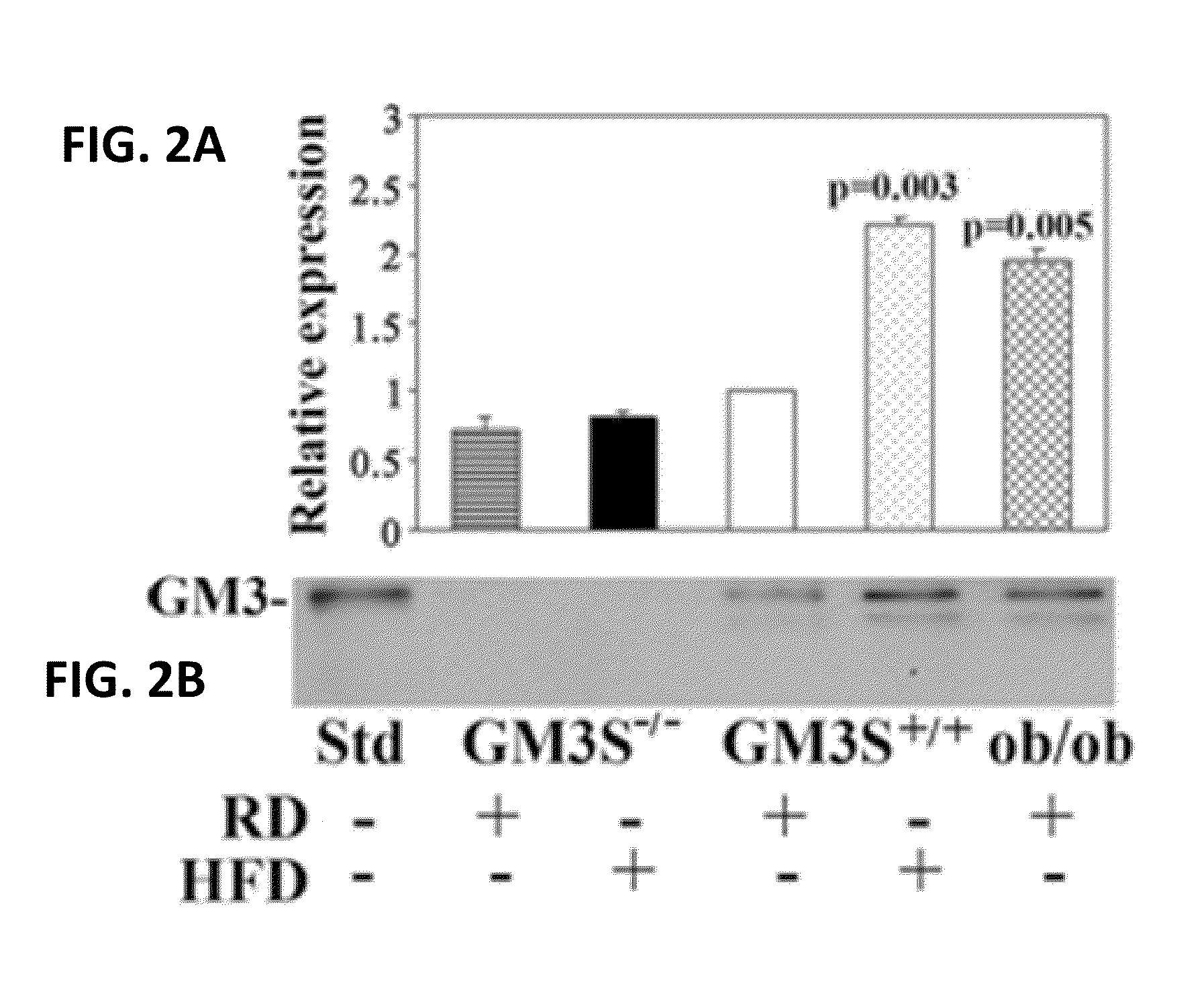Promotion of wound healing
a wound healing and wound technology, applied in the field of wound healing promotion, can solve the problems of affecting the healing process, affecting the healing effect, so as to promote wound healing, promote wound healing, and promote wound healing
- Summary
- Abstract
- Description
- Claims
- Application Information
AI Technical Summary
Benefits of technology
Problems solved by technology
Method used
Image
Examples
example 1
GM3 Mediates Both Hyperglycemia-Induced and Cytokine-Induced Insulin Resistance in Human Epidermal KCs (HEKs), While Ganglioside Depletion Promotes Diabetic Wound Healing in Obese Mice
[0042]Experiments conducted during the development of embodiments of the present invention demonstrate that the skin of diabetic mice (DIO and ob / ob), as their adipose tissue and muscle, shows increased expression of GM3S (SEE FIG. 2, top) and GM3 (SEE FIG. 2, bottom), suggesting that GM3 could directly suppress insulin signaling in skin. Data also demonstrate that ganglioside depletion by knockout of GM3S promotes wound healing in DIO mice, markedly accelerating epidermal wound closure (SEE FIG. 6). GM3 is increased in HEKs by chronic exposure to either low concentrations of TNF-α (SEE FIGS. 3A,B), as occurs in obesity, or increased glucose, simulating hyperglycemia (SEE FIGS. 3C,D), indicating that GM3 is a mediator of both cytokine- and hyperglycemia-induced insulin resistance. Experiments conducted...
example 2
Means for in Vivo Ganglioside Depletion Through Topical Application
[0043]Two techniques were used to deplete gangliosides in in vitro studies and to accelerate wound healing in mouse models of diabetes: i) glucosylceramide synthase (GCS) inhibition with C9; and ii) gene suppression of GM3S. Newer small molecule inhibitors of GCS, such as C9 and EtDOP4, deplete GM3 (SEE FIG. 3E), including the increased KC GM3 with supplemental glucose (SEE FIG. 3F). In contrast to the first GCS inhibitor PDMP, neither C9 nor EtDOP4 increase ceramide (SEE FIGS. 1, 3G) (Lee et al. J Biol Chem 1999; 274:14662-9.; Natoli et al. Nat Med 2010; 16:788-92.; Wang et al. J Invest Dermatol 2006; 126:2687-96.; Abe et al. J Lipid Res 1995; 36:611-21.; herein incorporated by reference in their entireties). In fact, ceramide exacerbates obesity-associated insulin resistance (22, herein incorporated by reference in its entirety). GCS inhibitors show promise in reversing insulin resistance, hepatic steatosis and ath...
example 3
Gangliosides Impact on Keratinocyte Motility
[0044]Experiments conducted during development of the present invention indicate that GM3 mediates hyperglycemia- and cytokine-driven insulin resistance in diabetic skin. These findings were extended from observations of increased GM3 in diabetic mouse skin to evaluate the effect of genetic ganglioside depletion on wound healing in GM3 synthase knockout GM3S(GM3S− / − or KO) mice. After 10 weeks on a high fat diet (HFD for DIO mice), GM3S− / − KO mice (without GM3 in skin, SEE FIG. 2) were as obese as DIO littermates and as hyperglycemic (random blood glucose levels KO 187.7±43.5 mg / dl, WT 170.8±46.0 mg / dl); however, DIO KO mice have improved insulin sensitivity; at 120 mins after glucose challenge and overnight fast, DIO KO mouse glucose levels are 170.9±13.1, not different from regular diet (RD) WT mice (161.3±8.5 mg / dl), but much less than DIO WT mice (274.9±17.6 mg / dl) (n≧12, each group) (Yamashita et al. Proc Natl Acad Sci USA 2003; 100:3...
PUM
| Property | Measurement | Unit |
|---|---|---|
| inner diameter | aaaaa | aaaaa |
| inner diameter | aaaaa | aaaaa |
| blunt force | aaaaa | aaaaa |
Abstract
Description
Claims
Application Information
 Login to View More
Login to View More - R&D
- Intellectual Property
- Life Sciences
- Materials
- Tech Scout
- Unparalleled Data Quality
- Higher Quality Content
- 60% Fewer Hallucinations
Browse by: Latest US Patents, China's latest patents, Technical Efficacy Thesaurus, Application Domain, Technology Topic, Popular Technical Reports.
© 2025 PatSnap. All rights reserved.Legal|Privacy policy|Modern Slavery Act Transparency Statement|Sitemap|About US| Contact US: help@patsnap.com



